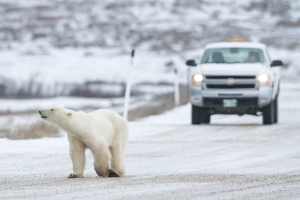
Wildlife
Think like a bear: learning to coexist
Humans and bears are sharing more landscapes now than ever before. As we continue to invade their world, will we be able to coexist?
- 4432 words
- 18 minutes
People & Culture

Talking with Bears is a portrait of Charlie Russell’s philosophy of nature. The book is a narrative story, written as if Russell was speaking to you. The Alberta naturalist died in May 2018 after years of work with grizzly bears, including reintegrating orphaned grizzlies into the wilds of Kamchatka.
Author G.A. Bradshaw also wrote Elephants on the Edge: What Animals Teach Us About Humanity and Carnivore Minds: Who these Fearsome Animals Really Are.
Below is the preface from Talking with Bears.
A female brown bear is standing on a grassy bench looking down at a patchwork of snow and turf. Her nose lifts as the wind passes. The air carries the sweetness of blossoms and the quiet growl of a snowmelt river. It is summer in Kamchatka, Russia’s far eastern peninsula. For seven months, the land has rested in frozen slumber.
Now, with the season’s warmth, life bursts into a raucous cavalcade of colour – streams choked with crimson salmon, meadows laughing green and stark sky beaming blue. It is bear time, time to glean every calorie possible in preparation for the coming winter. The subject of the bear’s gaze is a man with tousled grey hair and wellie boots. He is sitting on a pocket of grass nestled between the arms of a snowbank. Two bear cubs are playing near him. Without shifting her gaze, the bear begins to walk slowly toward the man and cubs. There is intention in her pace. Suddenly, an explosion of life disrupts the tranquility. The cubs have caught sight of their mother. They run joyously toward her, their faces open with broad, toothy smiles. The adults – man and bear – exchange silent greetings in the space above the chaos of rambunctious youth. Cub minding duties finished for the day, the man rises and tucks his camera back into its case. As he leaves, he glances back at the mother and child reunion. The female, who would come to be known as Brandy, is lying on her back with her cubs nursing eagerly. Walking stick in hand, the man heads for home. It’s been a grand day.
Brandy was a female brown bear living in the wilderness of Kamchatka. One day she spied a man walking in her neighbourhood. It was unusual to see humans in these parts, and when she did, they carried weapons to kill bears. This man did not. His hand held only the grace of an alder staff.
She began visiting his small wooden cabin nestled in the distant folds of the volcano’s skirts and took to harvesting pine nuts in the stand of trees outside the compound and sleeping on the path leading to the lake where the man collected water for cooking. This was how their friendship began.
There are times when two people meet and instantly connect, not because of any commonality in features or family but because their souls ignite in recognition. Charlie was to meet and befriend many bears to come, but, aside from the parental bonds developed with the ten orphaned cubs he raised and reintroduced back into the wild, his relationship with Brandy was by far the most influential and profound. He would achieve what few or none have. Not only did he forge a deep friendship with a wild adult bear, he was invited into the most sacred circle of brown bear society – the care of young bears. For seven years, he was nanny to three sets of Brandy’s children.
Charlie Russell was the chief architect of the change in how grizzly bears, North America’s counterpart to Russia’s brown bears, are perceived today. Old out-of-step-with-reality regulations are still in place, but they have lost their monolithic power over public opinion. His gentle narratives forever vanquished the myths that have imprisoned bears in the amber of human prejudice.
Built on nine years of conversations together, this book explores the philosophy, methods and sensibilities of Charlie Russell’s science, spanning seven decades of living with bears in North America and Russia. It describes an ontology and episteme, a way of existing and knowing, which he shared with bears and the rest of nature. These accounts provide a unique opportunity to experience an intact universe, the world before humanity imposed its fear-sharpened fences forcing separation from nature.
What Charlie accomplished takes rare courage. Not the kind that held his feet planted in a field of goldenrods as a 600-pound brown bear bore down on him, one day in Kamchatka. That was confidence, the kind that began in the heart and grew with intelligence from years of patient learning and caring. Charlie’s real courage lay elsewhere.
What sets him apart and is truly remarkable is the fortitude with which he weathered social dismissal and outrage for re- fusing to play humanity’s game in favour of revealing nature’s reality. His unyielding loyalty to nature and truth was regarded as an unforgivable betrayal. Although the exigencies were often painful and, at times, even life-threatening, he never wavered. He never forsook his allegiance to nature despite incessant demands and hardship.
The contradictions and controversy surrounding Charlie do not derive from the man, or the bears, but rather from a human reluctance to do what he did – drop all protective guards of human privilege and walk unarmed in the terrain of the soul, in the space of stillness from which all life springs. In this space, where the bears live, we hear voices of other teachers who advocate for the embrace of a new, but ancient, way of being – what Richard Rohr refers to as nondual thinking, Eckhart Tolle, presence, Thich Nhat Hanh, loving kindness, and quantum physicist David Bohm, wholeness. Charlie simply called it love.
The Navajo have a saying, ho?zho?, “May you walk in beauty.” Charlie walked in beauty.
He lives on in the bears and in their children’s children. He must be legend, a hero whose tale is told from one generation of bears to the next. Maybe Brandy wasn’t looking for a cub minder. Maybe she hired Charlie as an excuse to get to know this extraordinary being. Perhaps she knew that he’d be the one who would be able to teach humans how to smell the sweet blossoms and listen to the river’s song the way she did that day when this gentle man walked into her life.
This is what Charlie and the bears teach and this is their invitation to join them.
Are you passionate about Canadian geography?
You can support Canadian Geographic in 3 ways:

Wildlife
Humans and bears are sharing more landscapes now than ever before. As we continue to invade their world, will we be able to coexist?

People & Culture
Depending on whom you ask, the North’s sentinel species is either on the edge of extinction or an environmental success story. An in-depth look at the complicated, contradictory and controversial science behind the sound bites

Wildlife
Salmon runs are failing and grizzlies seem to be on the move in the islands between mainland B.C. and northern Vancouver Island. What’s going on in the Broughton Archipelago?

Wildlife
An excerpt from Gloria Dickie’s book, Eight Bears: Mythic Past and Imperiled Future, which explores the planet’s eight remaining species of bears and the dangers they face